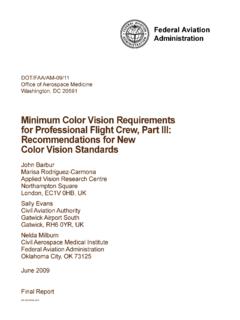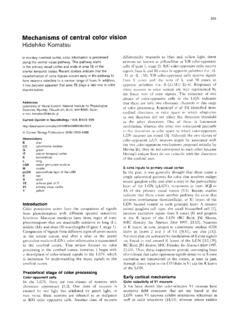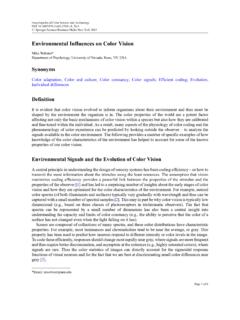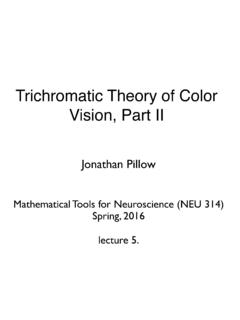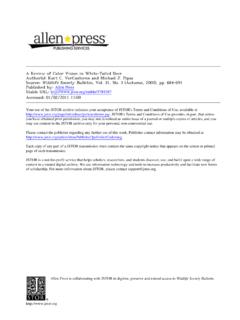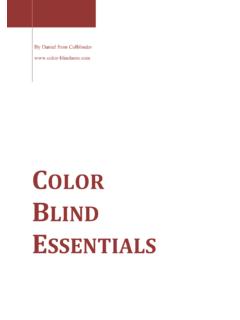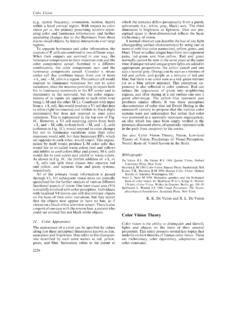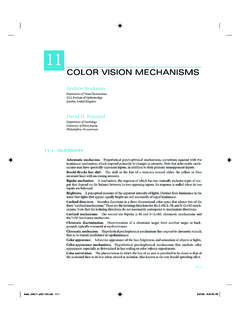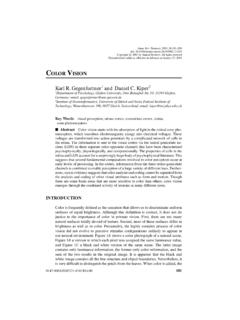Transcription of TETRACHROMATIC COLOR VISION - UCI Social Sciences
1 TETRACHROMATIC COLOR VISIONK imberly A. Jamesonprepared forThe Oxford Companion to , P., Bayne, T. & Cleeremans, A. ( ).Oxford University Press: appear in term tetrachromacy describes the physiological possession of four differentclasses of simultaneously functioning retinal photopigments (also called weaktetrachromacy ). From an empirical standpoint, TETRACHROMATIC COLOR VISION (or strong tetrachromacy ) additionally requires demonstrating that mixtures offour independent appropriately chosen primary lights will simulate all distinc-tions in appearance possible in visible COLOR space. Independence of the primarylights implies that no mixtures of any subset of these lights (or their intensityvariants) will produce an identical match to any combination of mixtures of theremaining lights. By comparison, trichromacy empirically requires only threeprimaries to simulate all visible theory states that normal COLOR VISION humans are trichromats(as, primarily, are Old World monkeys and apes).
2 The first element of trichro-macy is the output from three simultaneously functioning retinal cone classes:Short-, Medium-, and Long- Wavelenth Sensitive (SWS, MWS, & LWS) cone classes alone do not establish a trichromat COLOR code, however. Apostreceptoral code for three categories of signal is also needed. A standardvision science assumption is that the postreceptoral recoding of cone outputsinitiates the neural trivariant (or trichromatic) property of human COLOR percep-tion, and the need for only three primary lights to match any test TETRACHROMACY:Tetrachromacy is an early vertebrate characteristic, existing in fish and reptiles,and is evolutionarily more ancient than primate trichromacy. Essentially all diu-ral birds have four retinal cone types (two SWS classes, plus a MWS and a LWSclass) which neurally produce four dimensional COLOR experience, or tetrachro-matic COLOR VISION .
3 Such birds likely perceive a greater number of distinct colors1compared to humans, and many more colors compared to dichromat , non-human Old World primates tend to be trichromatic and NewWorld primates dichromatic. Recent studies find some New World monkeys the squirrel monkey, spider monkey, marmoset, and dusky titi are COLOR vi-sion polymorphic species in which the base condition is dichromacy, although aconsiderable proportion of individuals are trichromats (Jacobs 1996, Jacobs &Deegan 2005). Many animal species ( , squirrels, rabbits, some fishes, catsand dogs) are dichromatic (as are some COLOR deficient humans) and possess onlytwo functioning classes of cone photopigments and need only two primary lightsto match the COLOR of any test HUMAN TETRACHROMACY:Physiological considerations of potential human tetrachromacy began in the1940 s with genetic studies of inherited COLOR VISION deficiencies or Daltonism.
4 Approximately 8% of Caucasian males exhibit some degree of COLOR VISION defi-ciency caused by inheriting altered LWS and MWS photopigment genes on theX-chromosome. By possessing a single X chromosome males are less likely toexpress both LWS and MWS retinal photopigments compared to females withtwo X chromosomes. Furthermore, a female carrying altered photopigmentgenes may not experience COLOR VISION deficiency, although her male off-springwill likely inherit COLOR VISION deficiency. Photopigment gene deletions duringexpression (due to intergenic nonhomologous recombination), and alterations(due to missense mutations, coding sequence deletions, or intragenic cross overbetween different genes) underlie Daltonism. Failure to express either the LWSor MWS photopigment produces a Daltonian form of dichromacy, and expres-sion of altered photopigment genes can lead to COLOR VISION many years scientists have known that some fraction of human femalesinherit the genetic potential to produce four cone photopigment variants, andactually express these variants as distinct retinal cone classes with four differentspectral sensitivity distributions.
5 Certain females of heterozygous genotypescan express both altered and normal forms of photopigment genes thoughtto underlie COLOR matching differences. Retinal expression of four distinct coneclasses requires random X inactivation during embryonic development so thatgenes from both altered and normal pigment genes are alternatively expressedas photopigments across the retina s cone cell mosaic. The resulting mosaicmay include a patchwork of usual SWS, MWS and LWS cone types, plus, forexample, a fourth long wavelength class variant with peak sensitivity differingfrom the usual LWS class by 4 7 nm. Frequency estimates of female Caucasianswho are potential tetrachromats range between 15% and 47% depending on theheterozygote genotypes considered. Less is know about the actual frequency ofexpressing four retinal cone the potential for human tetrachromacy exists, the general theory sug-gests that humans process no better than a trivariant COLOR signal.
6 Thus, fourretinal cone classes are a necessary (but not a sufficient) condition for tetrachro-matic COLOR perception, and for true tetrachromacy a tetra variant COLOR signal2processing is also scientists conjecture that humans with four retinal photopigment classesmight experience a dimension of perceptual experience denied to trichromat in-dividuals (Jordan & Mollon 1993); implying that cortically humans might pro-cess four COLOR channels, or otherwise learn to use the additional World primate trichromacy suggests a parallel: Female spider monkeyspossessing extra photopigment gene variants are trichromats, while both malesand females without such variants experience only dichromat COLOR VISION . Genevariants thereby allow some female monkeys to experience a dimension of colorexperience that other females and males do not (Jordan & Mollon 1993).EMPIRICAL STUDIES OF HUMAN TETRACHROMACY:Anomaloscope Investigations:Typically, psychophysical anomaloscope COLOR -matching investigations are usedto study human tetrachromacy.
7 In an anomaloscope task observers monocu-larly view a bipartite field of primary mixtures and adjust the primaries in onehalf-field until a COLOR match with a fixed test light in the other half-fieldis obtained. Nagy, MacLeod, Heyneman & Eisner (1981) examined potentialtetrachromacy using such a task with chromatic annulus-surround stimuli anda large-field Rayleigh Match task variant. Jordan & Mollon (1993) used bothlarge-field Rayleigh matching and a ratio-matching task where ratios of pairs ofprimary lights are mixed to match a test light. For evaluating signal process-ing mechanisms most anomalscope investigations distinguish weak and strong forms of tetrachromacy to interpret mixture settings of potential tetrachromacy occurs if an observer has four different cone classes butlacks the postreceptoral capacity to transmit four truly independent COLOR sig-nals.
8 Nagy et al. (1981) demonstrated this form in potential tetrachromatswho accepted trichromatic COLOR matches made in a context-free (black annu-lus) background condition, but did not exhibit the stability of such matchesunder different chromatic background conditions (unlike trichromats). The ob-servation that matched fields become distinguishable in a colored backgroundclearly indicates weak tetrachromacy, suggesting that the kind of stimulus addi-tivity found in trichromats fails for some potential tetrachromats, or that signalsfrom the extra cone class produce perceptual differences when viewing is con-textualized. Nagy et al. (1981) also imply that tetrachromat retinal mosaicismmay be a contributing factor in their tetrachromacy arises from four different cone types plus the capacityto transmit four independent cone signals. Such observers would reject large-field trichromat COLOR matches and require four variables to match all & Mollon (1993) showed 8 out of 14 candidate tetrachromats refusedlarge-field Rayleigh matches providing preliminary evidence for [the strongform of] tetrachromacy ( ).
9 They also identified two subjects with pre-cise matches in a ratio matching task (as would have been expected from atetrachromat in their experiment), suggesting one subject s tetrachromacy isnot of the form we initially envisaged (p. 1503) although she remains in play3as a candidate tetrachromat in the strong sense (p. 1505). Jordan & Mollon(1993) nevertheless remain tentative concerning the existence of strong interpretions of both Nagy et al. (1981) and Jordan & Mol-lon (1993) suggest weak tetrachromacy interferes with the ability of potentialtetrachromats to repeat match mixture settings when producing mixtures withfewer than four variables. In this regard, at least, some potential tetrachromatsdiffer from factors are likely to influence the empirical identification of hu-man tetrachromats: Complexity of COLOR experience will increase with scene,stimulus, and viewing complexity.
10 Monocularly viewed stimuli used in anoma-loscope investigations impose empirical constraints on the dimensionality ofperceptual experience, whereas naturalistic binocular viewing of contextualizedscenes is more likely to uncover tetrachromacy. Thus, the empirical detection ofhuman tetrachromacy is more likely to occur under complex stimuli and Investigations:Some investigations have employed increased stimulus complexity, examinedmore natural processing conditions and behaviors, and obtained human ob-server genotype information (Jameson, Highnote & Wasserman 2001, Jame-son, Bimler & Wasserman 2006, Sayim, Jameson, Alvarado & Szeszel 2005).These investigations used molecular genetic methods to identify potential reti-nal tetrachromats, and found differences in perceptual behaviors when a geneticpotential existed for more than three photopigment classes. Behaviors thatdifferentiated these potential tetrachromats from trichromat controls includedperceiving more colors in diffracted spectra (Jameson et al.)
